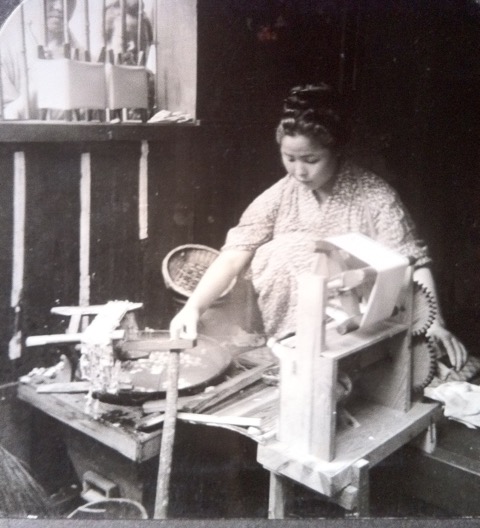
All photos courtesy of Glennis Dolce.
This weekend, Glennis Dolce will be leading an exciting new two-day workshop called From Moth to Cloth, which explores the Japanese tradition of silkworm rearing. Participants will work with actual silk cocoons, learning how to reel thread using a traditional silk reeling device (zakuri) and make silk hankies (mawata) out of them.
Legend has it that silk was first discovered in China in 2460 BC by the Empress Xi Ling Shi, who was drinking tea under a mulberry tree one day when a cocoon fell into her cup and began to unravel. She became fascinated with the shimmering thread and proceeded to study it. She soon learned how to cultivate silkworms, reel their thread, and weave beautiful garments out of the material. Silk clothing became the province of royalty for many years, before the popularity of the material slowly became more widespread, eventually reaching across the globe. Empress Xi Ling Shi is now honored as the goddess of silk.
After being kept secret in China for hundreds of years, the silk making process finally found its way to Japan, with various sources dating its arrival between 200 and 400 AD. By the eighth century AD, sericulture was thriving there, with Gumma Prefecture rising to become the country’s principal silk producing region. During the 20th century, the silk industry experienced ups and downs; the advent of industrialization, the invention of nylon, and the popularization of Western tastes finally brought about a decline in the global silk market at the end of the 1970s. Silk remains, however, an important and popular fine fabric, and fascination with the process of sericulture continues.

depicts a woman in Japan reeling silk on a zakuri.
We asked Dolce, who has traveled to Japan many times to learn about this subject, what silk production there is like today. This is what she told us: “While sericulture in the past was a cottage industry widely practiced by Japanese small-scale farmers in their homes, today there are improved techniques that even small-scale sericulturists practice that allow them to produce large numbers of cocoons. Regional sericulture groups hatch and raise large numbers of silkworms in laboratory-style settings with perfect environmental conditions, and deliver the silkworms to farmers once they have reached their third instar, allowing farmers to finish the process (feeding with fresh mulberry leaf) and the cocooning. This allows farmers to produce up to four readings in a single season. Most of these sericulturists are small-scale operations, with the farmer living near or on the same property.”

This photo was taken at the Usui filature mill in Japan.
“Most commercial silk cocoons come from India and China these days,” Dolce added. “Japan’s production is rather specialized, focusing on domestic and high-end silk. I don’t think they export any silk cocoons at all. I believe that Japanese cocoons are almost exclusively reeled and used in Japan.”
This weekend, try your own hand at reeling silk, making mawata, and crafting and dyeing with silk cocoons. Sign up for From Moth to Cloth here. For inspiration, check out Glennis Dolce’s favorite silkworm website, Wormspit. You can also read about the history of sericulture in California, brought over by Japanese immigrants in the 19th century. And if you can read Japanese, you can learn about Dolce’s teacher in Japan here.




